Using MODIS-NDVI for the Modeling of Post-Wildfire Vegetation Response as a Function of Environmental Conditions and Pre-Fire Restoration Treatments
Abstract
:1. Introduction
1.1. Monitoring and Modeling Wildfire Effects
1.2. Modeling Post-Fire Trend
2. Data and Methods
2.1. Analyzing Fire Events in the South West USA
2.2. Study Area
2.3. Research Design
2.4. Vegetation Response after Fire
2.5. Environmental and Human Factors Affecting Vegetation Response
2.6. Modeling Post-Fire Vegetation Response
2.6.1. Sampling for Modeling
2.6.2. Modeling Vegetation Response per Pre-Fire Treatment
2.6.3. Modeling Vegetation Response per Fire
3. Results, Analysis and Discussion
3.1. Post-Fire Vegetation Response
3.2. Environmental Influence on Vegetation Trends per Pre-Fire Treatment
3.2.1. Factors Influencing Post-Fire Vegetation Response
3.2.2. Environmental Influences on Post-Fire Vegetation Response
3.3. Environmental and Pre-Fire Treatment Influences on Vegetation Trends per Fire
3.3.1. Natural and Human Factors Affecting Post-Fire Vegetation Response
3.3.2. Pre-Fire Treatment Effects
4. Conclusions and Future Work
Acknowledgments
References
- Westerling, A.L.; Hidalgo, H.G.; Cayan, D.R.; Swetnam, T.W. Warming and earlier spring increase western US forest wildfire activity. Science 2006, 313, 940–943. [Google Scholar]
- Stephens, S.L.; Moghaddas, J.J.; Edminster, C.; Fiedler, C.E.; Haase, S.; Harrington, M.; Keeley, J.E.; Knapp, E.E.; McIver, J.D.; Metlen, K.; Skinner, C.N.; Youngblood, A. Fire treatment effects on vegetation structure, fuels, and potential fire severity in western US forests. Ecol. Appl 2009, 19, 305–320. [Google Scholar]
- Fulé, P.Z.; Covington, W.W.; Smith, H.B.; Springer, J.D.; Heinlein, T.A.; Huisinga, K.D.; Moore, M.M. Comparing ecological restoration alternatives: Grand Canyon, Arizona. For. Ecol. Manage 2002, 170, 19–41. [Google Scholar]
- Pollet, J.; Omi, P.N. Effect of thinning and prescribed burning on crown fire severity in ponderosa pine forests. Int. J. Wildland Fire 2002, 9, 1–10. [Google Scholar]
- Baker, W.L. The landscape ecology of large disturbances in the design and management of nature reserves. Landscape Ecol 1992, 7, 181–194. [Google Scholar]
- White, P.S.; Jentsch, A. The search for generality in studies of disturbance and ecosystem dynamics. Prog. Bot 2001, 62, 399–450. [Google Scholar]
- White, P.S.; Pickett, S.T.A. Natural disturbance and patch dynamics: An introduction. In The Ecology of Natural Disturbance and Patch Dynamics; Academic Press: Orlando, FL, USA, 1985; pp. 3–13. [Google Scholar]
- Turner, M.G.; Gardner, R.H.; O’Neill, R.V. Landscape Ecology in Theory and Practice: Pattern and Process; Springer: New York, NY, USA; p. 2001.
- McKenzie, D.; Gedalof, Z.; Peterson, D.L.; Mote, P. Climatic change, wildfire, and conservation. Conserv. Biol 2004, 18, 890–902. [Google Scholar]
- Hall, D.K.; Ormsby, J.P.; Johnson, L.; Brown, J. Landsat digital analysis of the initial recovery of burned tundra at Kokolik River, Alaska. Remote Sens. Environ 1980, 10, 263–272. [Google Scholar]
- Turner, M.G.; Romme, W.H. Landscape dynamics in crown fire ecosystems. Landscape Ecol 1994, 9, 59–77. [Google Scholar]
- Turner, M.G.; Romme, W.H.; Gardner, R.H. Pre-fire heterogeneity, fire severity, and early post-fire plant reestablishment in subalpine forests of Yellowstone National Park, Wyoming. Intl J. Wildland Fire 1999, 9, 21–36. [Google Scholar]
- Neary, D.G.; Klopatek, C.C.; DeBano, L.F.; Ffolliott, P.F. Fire effects on belowground sustainability: a review and synthesis. For. Ecol. Manage 1999, 122, 51–71. [Google Scholar]
- Lentile, L.B.; Holden, Z.A.; Smith, A.M.S.; Falkowski, M.J.; Hudak, A.T.; Morgan, P.; Lewis, S.A.; Gessler, P.E.; Benson, N.C. Remote sensing techniques to assess active fire characteristics and post-fire effects. Int. J. Wildland Fire 2006, 15, 319–345. [Google Scholar]
- Epting, J.; Verbyla, D.; Sorbel, B. Evaluation of remotely sensed indices for assessing burn severity in interior Alaska using Landsat TM and ETM+. Remote Sens. Environ 2005, 96, 328–339. [Google Scholar]
- Key, C.H.; Benson, N.C. Landscape assessment: Ground measure of severity, the Composite Burn Index, and remote sensing of severity, the Normalized Burn Ratio. In FIREMON: Fire Effects Monitoring and Inventory System; Lutes, D.C., Keane, R.E., Caratti, J.F., Key, C.H., Benson, N.C., Sutherland, S., Gangi, L.J., Eds.; USDA Forest Service, Rocky Mountain Research Station: Fort Collins, CO, USA; p. 2006.
- Casady, G.; Leeuwen, W.; Marsh, S. Evaluating post-wildfire vegetation regeneration as a response to multiple environmental determinants. Environ. Model. Assess 2010, 15, 295–307. [Google Scholar]
- Swetnam, T.W.; Baisan, C.H. Historical fire regime patterns in the Southwestern United States since AD 1700. In Fire Effects in Southwestern Fortest: Proceedings of the 2nd La Mesa Fire Symposium; Allen, C.D., Ed.; General Technical Report RM-GTR-286; USDA Forest Service: Fort Collins, CO, USA, 1996. [Google Scholar]
- IPCC, Climate Change 2007: Synthesis Report. Contribution of Working Groups I, II and III to the Fourth Assessment; Report of the Intergovernmental Panel on Climate Change; Pachauri, R.K.; Reisinger, A. (Eds.) Intergovernmental Panel on Climate Change: Geneva, Switzerland, 2007; p. 104.
- Flannigan, M.D.; Stocks, B.J.; Wotton, B.M. Climate change and forest fires. Sci. Total Environ 2000, 262, 221–229. [Google Scholar]
- Schoennagel, T.; Veblen, T.T.; Romme, W.H. The interaction of fire, fuels, and climate across Rocky Mountain forests. BioScience 2004, 54, 661–676. [Google Scholar]
- Touchan, R.; Allen, C.D.; Swetnam, T.W. Fire history and climatic patterns in ponderosa pine and mixed-conifer forests of the Jemez Mountains, Northern New Mexico. In Fire Effects in Southwestern Fortest: Proceedings of the 2nd La Mesa Fire Symposium; Allen, C.D., Ed.; USDA Forest Service: Fort Collins, CO, USA, 1996; pp. 33–46. [Google Scholar]
- Allen, C.D.; Savage, M.; Falk, D.A.; Suckling, K.F.; Swetnam, T.W.; Schulke, T.; Stacey, P.B.; Morgan, P.; Hoffman, M.; Jon, T.K. Ecological restoration of Southwestern Ponderosa Pine ecosystems: A broad perspective. Ecol. Appl 2002, 12, 1418–1433. [Google Scholar]
- North, M.; Innes, J.; Zald, H. Comparison of thinning and prescribed fire restoration treatments to Sierran mixed-conifer historic conditions. Can. J. For. Res 2007, 37, 331–342. [Google Scholar]
- Agee, J.K.; Skinner, C.N. Basic principles of forest fuel reduction treatments. For. Ecol. Manage 2005, 211, 83–96. [Google Scholar]
- Weatherspoon, P.C.; Skinner, C.N. Effect of thinning and prescribed burning on crown fire severity in ponderosa pine forest. Forest Sci 1995, 41, 430–451. [Google Scholar]
- Stephens, S.L. Evaluation of the effects of silvicultural and fuels treatments on potential fire behaviour in Sierra Nevada mixed-conifer forests. For. Ecol. Manage 1998, 105, 21–35. [Google Scholar]
- Casady, G.M.; van Leeuwen, W.J.D.; Marsh, S.E. Evaluating post-wildfire vegetation regeneration as a response to multiple environmental determinants. Environ. Model. Assess 2010, 15, 295–307. [Google Scholar]
- Reed, B.C.; Brown, J.F.; Vanderzee, D.; Loveland, T.R.; Merchant, J.W.; Ohlen, D.O. Measuring Phenological Variability from Satellite Imagery. J. Veg. Sci 1994, 5, 703–714. [Google Scholar]
- van Leeuwen, W.J.D.; Casady, G.M.; Neary, D.G.; Bautista, S.; Alloza, J.A.; Carmel, Y.; Wittenberg, L.; Malkinson, D.; Orr, B.J. Monitoring post-wildfire vegetation response with remotely sensed time-series data in Spain, USA and Israel. Int. J. Wildland Fire 2010, 19, 75–93. [Google Scholar]
- Zhou, L.M.; Tucker, C.J.; Kaufmann, R.K.; Slayback, D.; Shabanov, N.V.; Myneni, R.B. Variations in northern vegetation activity inferred from satellite data of vegetation index during 1981 to 1999. J. Geophys. Res.-Atmos 2001, 106, 20069–20083. [Google Scholar]
- Casady, G.M.; Marsh, S.E. Broad-scale environmental conditions responsible for post-fire vegetation dynamics. Remote Sens 2010, 2, 2643–2664. [Google Scholar]
- Maselli, F.; Moriondo, M.; Chiesi, M.; Chirici, G.; Puletti, N.; Barbati, A.; Corona, P. Evaluating the effects of environmental changes on the Gross Primary Production of Italian forests. Remote Sens 2009, 1, 1108–1124. [Google Scholar]
- Jensen, J.R. Biophysical remote sensing. Ann. Assoc. Am. Geogr 1983, 73, 111–132. [Google Scholar]
- Tucker, C.J.; Sellers, P.J. Satellite remote sensing of primary production. Int. J. Remote Sens 1986, 7, 1395–1416. [Google Scholar]
- Huete, A.; Didan, K.; Miura, T.; Rodriguez, E.P.; Gao, X.; Ferreira, L.G. Overview of the radiometric and biophysical performance of the MODIS vegetation indices. Remote Sens. Environ 2002, 83, 195–213. [Google Scholar]
- Avery, T.E.; Berlin, G.L. Fundamentals of Remote Sensing and Airphoto Interpretation, 5th ed.; Prentice Hall: Upper Saddle River, NJ, USA, 1992. [Google Scholar]
- Jensen, J.R. Introductory Digital Image Processing: A Remote Sensing Perspective, 3rd ed.; Pearson Prentice Hall: Upper Saddle River, NJ, USA, 2005. [Google Scholar]
- White, J.D.; Ryan, K.C.; Key, C.C.; Running, S.W. Remote sensing of forest fire severity and vegetation recovery. Int. J. Wildland Fire 1996, 6, 125–136. [Google Scholar]
- van Leeuwen, W.J.D. Monitoring the effects of forest restoration treatments on post-fire vegetation recovery with MODIS multitemporal data. Sensors 2008, 8, 2017–2042. [Google Scholar]
- Wimberly, M.C.; Cochrane, M.A.; Baer, A.D.; Pabst, K. Assessing fuel treatment effectiveness using satellite imagery and spatial statistics. Ecol. Appl 2009, 19, 1377–1384. [Google Scholar]
- Roy, D.P.; Boschetti, L.; Trigg, S.N. Remote sensing of fire severity: Assessing the performance of the normalized burn ratio. IEEE Geosci. Remote Sens. Lett 2006, 3, 112–116. [Google Scholar]
- Ramsey, F.L.; Schafer, D.W. The Statistical Sleuth: A Course in Methods of Data Analysis, 2nd ed.; Pacific Grove: Duxbury, CA, USA, 2002. [Google Scholar]
- Murthy, S.K. Automatic construction of decision trees from data: A multi-disciplinary survey. Data Min. Knowl. Disc 1998, 2, 345–389. [Google Scholar]
- Breiman, L.; Friedman, J.H.; Olshen, R.A.; Stone, C.G. Classification and Regression Trees; Wadsworth International Group: Belmont, CA, USA, 1984. [Google Scholar]
- De‘ath, G.; Fabricius, K.E. Classification and regression trees: A powerful yet simple technique for ecological data analysis. Ecology 2000, 81, 3178–3192. [Google Scholar]
- Davenport, D.W.; Wilcox, B.P.; Breshears, D.D. Soil morphology of canopy and intercanopy sites in piilon-juniper woodland. Soil Sci. Soc. Am. J 1996, 60, 1881–1887. [Google Scholar]
- Wilcox, B.P.; Newman, B.D.; Allen, C.D.; Reid, K.D.; Brandes, D.; Pitlick, J.; Davenport, D.W. Runoff and Erosion on the Pajarito Plateau: Observations from the Field; New Mexico Geological Society: Socorro, NM, USA, 1996. [Google Scholar]
- Conley, W.; Sivinski, R.; White, G. Responses of Elk (Cervus elaphus) and Mule Deer (Odocoileus hemionus) to Wildfire: Changes in Utilization and Migration Patterns; Bandelier National Monument: Los Alamos, NM, USA, 1979; p. 88. [Google Scholar]
- Rupp, S. Effects of Grazing and Trampling by Rocky Mountain Elk (Cervus elaphus nelsoni) on the Vegetative Community of Bandelier National Monument, New Mexico. M.S. Thesis, Texas Tech University, Lubbock, TX, USA. 2000. [Google Scholar]
- Balice, R.G.; Miller, J.D.; Oswald, B.P.; Edminster, C.; Yool, S.R. Forest Surveys and Wildfire Assessment in the Los Alamos Region 1998–1999; Los Alamos National Laboratory: Los Alamos, NM, USA, 2000; p. 86. [Google Scholar]
- Gamon, J.A.; Field, C.B.; Goulden, M.L.; Griffin, K.L.; Hartley, A.E.; Joel, G.; Penuelas, J.; Valentini, R. Relationships between NDVI, canopy structure, and photosynthesis in three Californian vegetation types. Ecol. Appl 1995, 5, 28–41. [Google Scholar]
- Epiphanio, J.N.; Huete, A.R. Dependence of NDVI and SAVI on sun/sensor geometry and its effect on fAPAR relationships in Alfalfa. Remote Sens. Environ 1995, 51, 351–360. [Google Scholar]
- Myneni, R.B.; Williams, D.L. On the relationship between FAPAR and NDVI. Remote Sens. Environ 1994, 49, 200–211. [Google Scholar]
- Richard, Y.; Poccard, I. A statistical study of NDVI sensitivity to seasonal and interannual rainfall variations in Southern Africa. Int. J. Remote Sens 1998, 19, 2907–2920. [Google Scholar]
- Schloss, A.L.; Kicklighter, D.W.; Kaduk, J.; Wittenberg, U. The Participants of the Potsdam NPP Model Intercomparison. Comparing global models of terrestrial net primary productivity (NPP): Comparison of NPP to climate and the Normalized Difference Vegetation Index (NDVI). Global Change Biol 1999, 5, 25–34. [Google Scholar]
- Myneni, R.B.; Ramakrishna, R.; Nemani, R.; Running, S.W. Estimation of global leaf area index and absorbed par using radiative transfer models. IEEE Trans. Geosci. Remote Sens 1997, 35, 1380–1393. [Google Scholar]
- Coops, N.C.; Waring, R.H.; Landsberg, J.J. Assessing forest productivity in Australia and New Zealand using a physiologically-based model driven with averaged monthly weather data and satellite-derived estimates of canopy photosynthetic capacity. For. Ecol. Manage 1998, 104, 113–127. [Google Scholar]
- Chavez, P.S., Jr. Image-based atmospheric corrections—Revisited and improved. Photogramm. Eng. Remote Sens 1996, 62, 1025–1036. [Google Scholar]
- Miller, J.D.; Thode, A.E. Quantifying burn severity in a heterogeneous landscape with a relative version of the delta Normalized Burn Ratio (dNBR). Remote Sens. Environ 2007, 109, 66–80. [Google Scholar]
- Longley, P.A.; Goodchild, M.F.; Maguire, D.J. Geographic Information Systems and Science, 2nd ed.; John Wiley and Sons: Chichester, UK; p. 2005.
- Jenson, S.K.; Domingue, J.O. Extracting topographic structure from digital elevation data for geographic information system analysis. Photogramm. Eng. Remote Sensing 1988, 54, 1593–1600. [Google Scholar]
- Moore, I.D.; Grayson, R.B.; Ladson, A.R. Digital terrain modeling—A review of hydrological, geomorphological, and biological applications. Hydrol. Processes 1991, 5, 3–30. [Google Scholar]
- Daly, C.; Gibson, W.P.; Taylor, G.H.; Johnson, G.L.; Pasteris, P. A knowledge-based approach to the statistical mapping of climate. Clim. Res 2002, 22, 99–113. [Google Scholar]
- Daly, C.; Neilson, R.P.; Phillips, D.L. A statistical-topographic model for mapping climatological precipitation over mountainous terrain. J. Appl. Meteorol. Clim 1994, 33, 140–158. [Google Scholar]
- Raupach, M.R.; Finnigan, J.J. The influence of topography on meteorological variables and surface-atmosphere interactions. J. Hydrol 1997, 190, 182–213. [Google Scholar]
- Flores, A.N.; Ivanov, V.Y.; Entekhabi, D.; Bras, R.L. Impact of hillslope-scale organization of topography, soil moisture, soil temperature, and vegetation on modeling surface microwave radiation emission. IEEE Trans. Geosci. Remote Sens 2009, 47, 2557–2571. [Google Scholar]
- Swanson, F.J.; Kratz, T.K.; Caine, N.; Woodmansee, R.G. Landform effects on ecosystem patterns and processes. BioScience 1988, 38, 92–98. [Google Scholar]
- Ali, G.A.; Roy, A.G.; Legendre, P. Spatial relationships between soil moisture patterns and topographic variables at multiple scales in a humid temperate forested catchment. Water Resour. Res 2010, 46, 1–17. [Google Scholar]
- Allan, J.D.; Erickson, D.L.; Fay, J. The influence of catchment land use on stream integrity across multiple spatial scales. Freshwater Biol 1997, 37, 149–161. [Google Scholar]
- Begum, F.; Bajracharya, R.M.; Sharma, S.; Sitaula, B.K. Influence of slope aspect on soil physico-chemical and biological properties in the mid hills of central Nepal. Int. J. Sustain. Dev. World 2010, 17, 438–443. [Google Scholar]
- Pachepsky, Y.A.; Timlin, D.J.; Rawls, W.J. Soil water retention as related to topographic variables. Soil Sci. Soc. Am. J 2001, 65, 1787–1795. [Google Scholar]
- Pan, B.; Geng, H.; Hu, X.; Sun, R.; Wang, C. The topographic controls on the decadal-scale erosion rates in Qilian Shan Mountains, N.W. China. Earth Planet Sc. Lett 2010, 292, 148–157. [Google Scholar]
- Pazzaglia, F.J.; Brandon, M.T. Macrogeomorphic evolution of the post-Triassic Appalachian mountains determined by deconvolution of the offshore basin sedimentary record. Basin Res 1996, 8, 255–278. [Google Scholar]
- Bertoldi, G.; Notarnicola, C.; Leitinger, G.; Endrizzi, S.; Zebisch, M.; Della Chiesa, S.; Tappeiner, U. Topographical and ecohydrological controls on land surface temperature in an Alpine catchment. Ecohydrology 2010, 3, 189–204. [Google Scholar]
- Herold, M.; Goldstein, N.C.; Clarke, K.C. The spatiotemporal form of urban growth: Measurement, analysis and modeling. Remote Sens. Environ 2003, 86, 286–302. [Google Scholar]
- Breiman, L.; Friedman, J.H.; Olshen, R.A.; Stone, C.G. Classification and Regression Trees; Chapman & Hall: New York, NY, USA; p. 1993.
- Turner, M.G.; Romme, W.H.; Gardner, R.H.; Hargrove, W.W. Effects of fire size and pattern on early succession in Yellowstone National Park. Ecol. Monogr 1997, 67, 411–433. [Google Scholar]
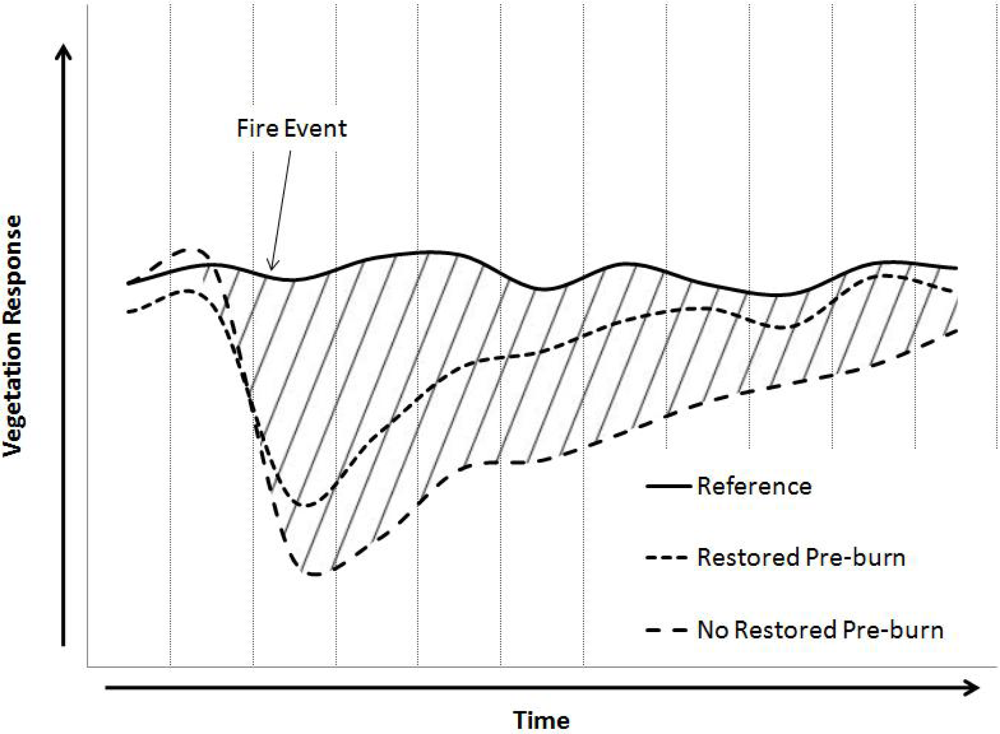

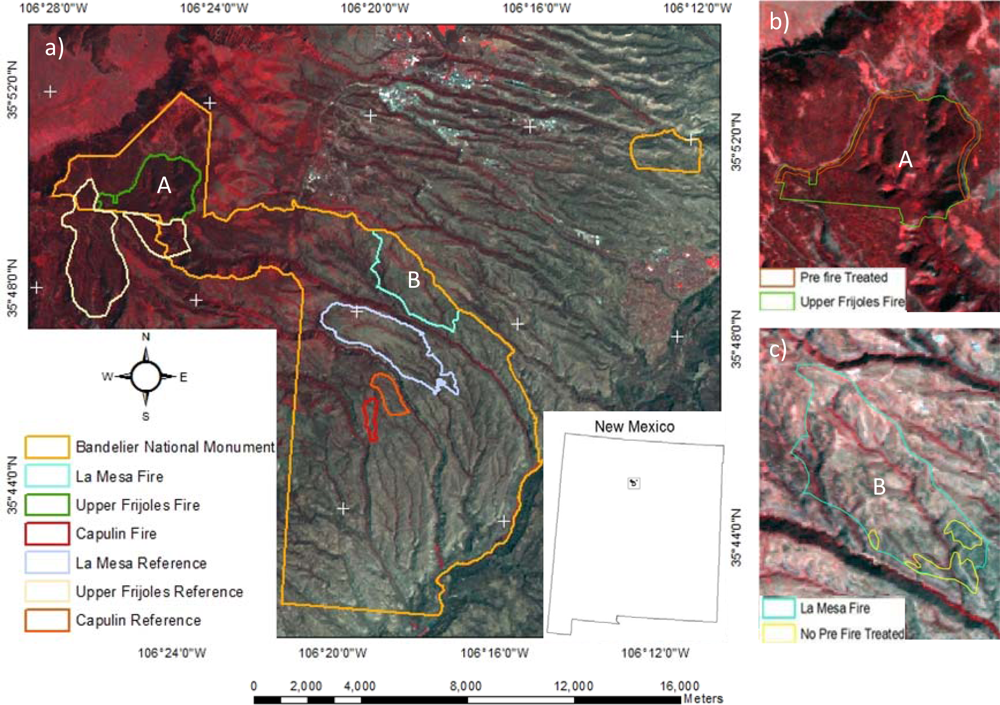
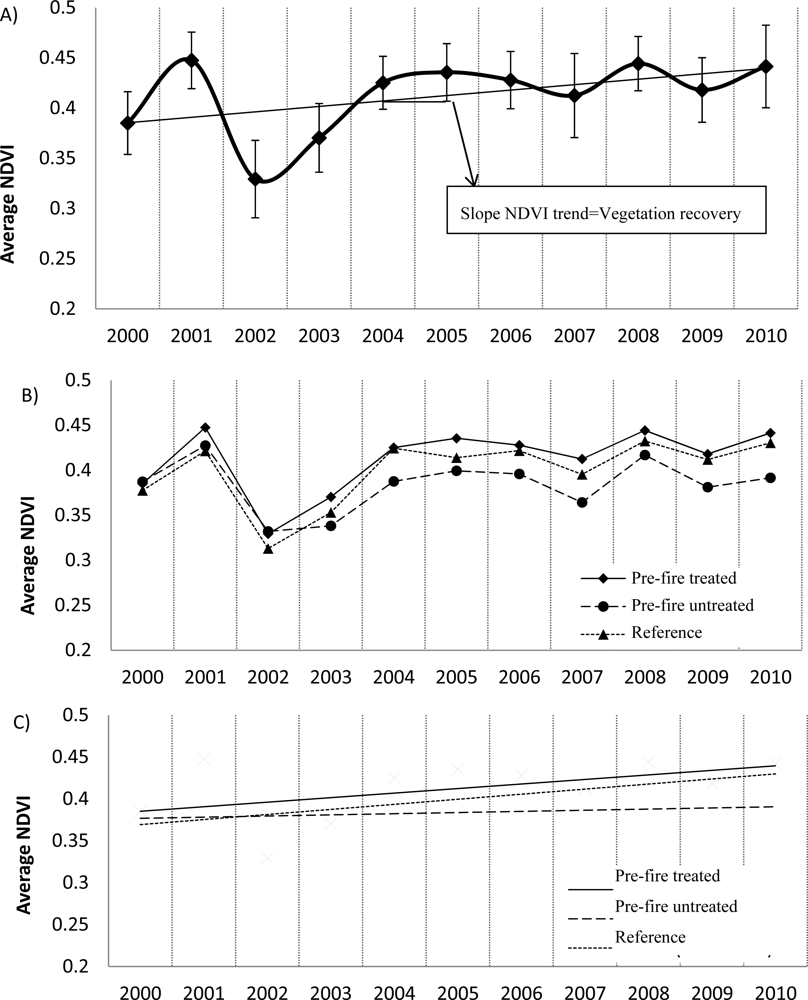
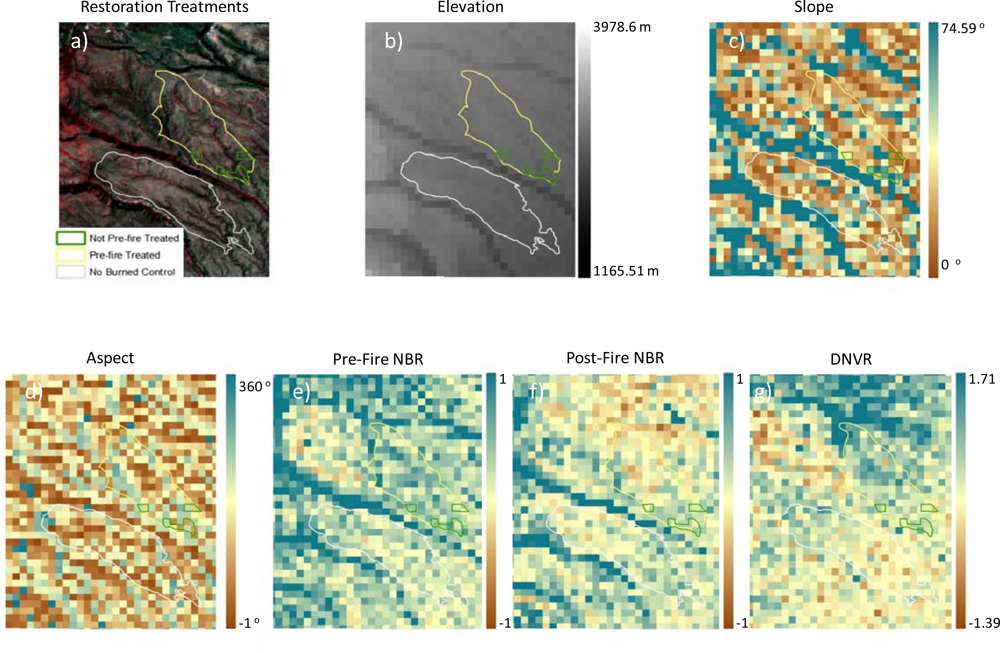
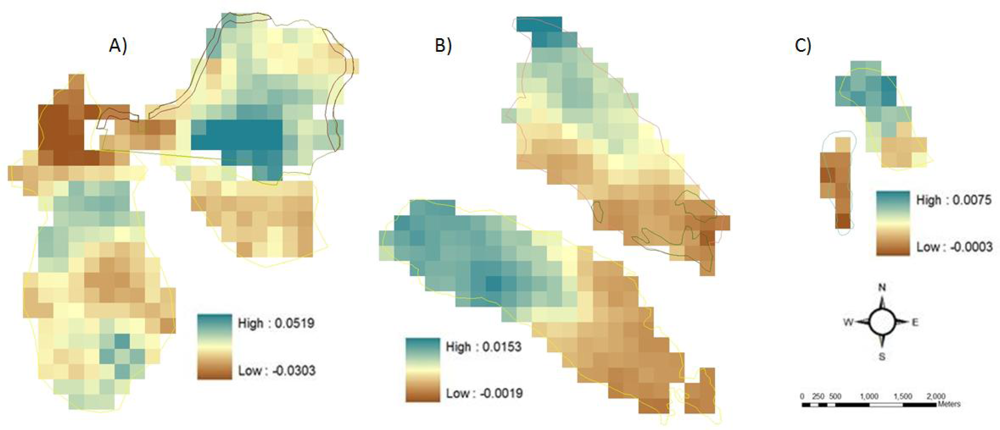
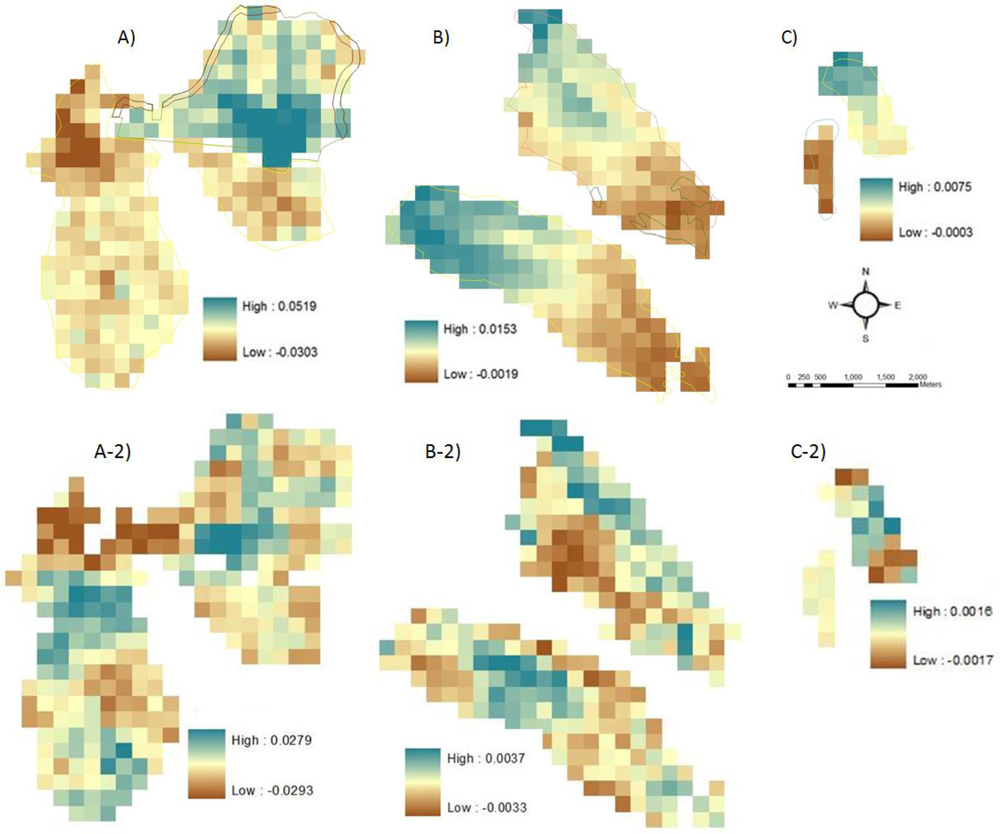
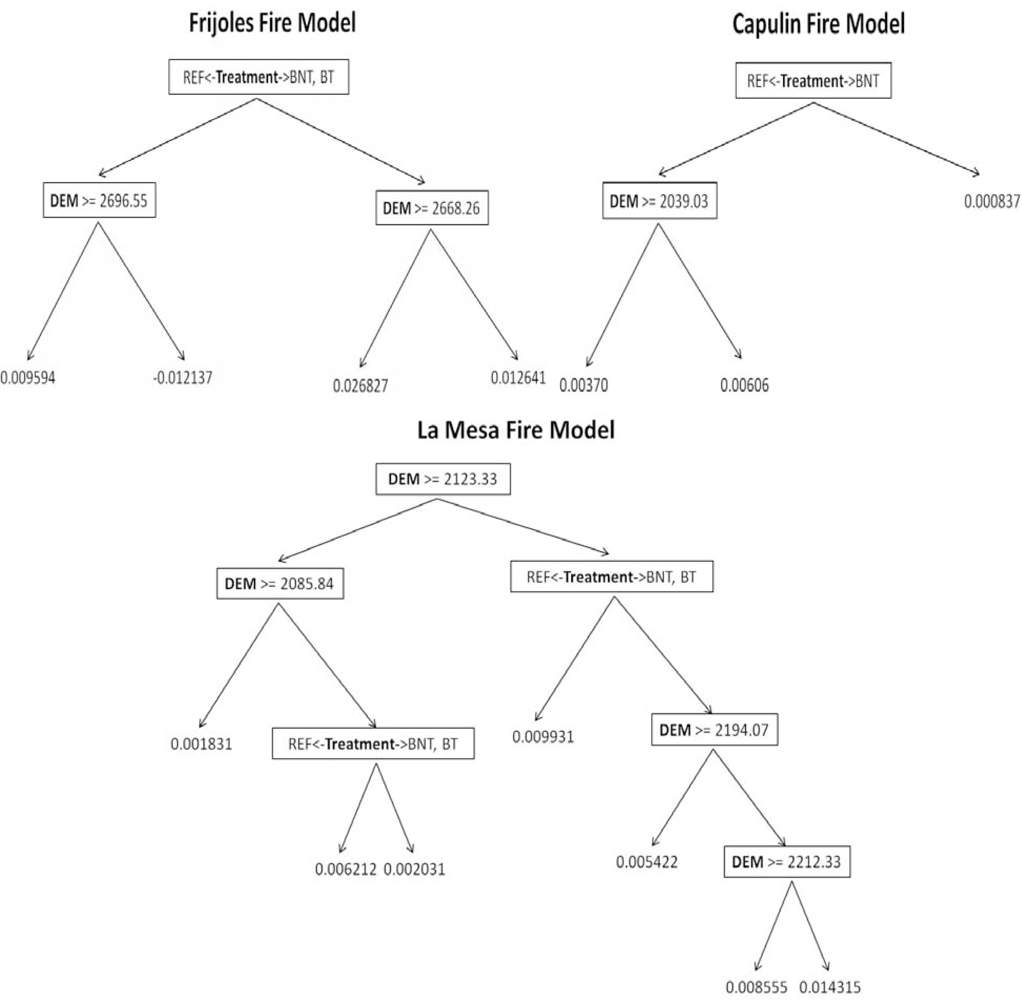
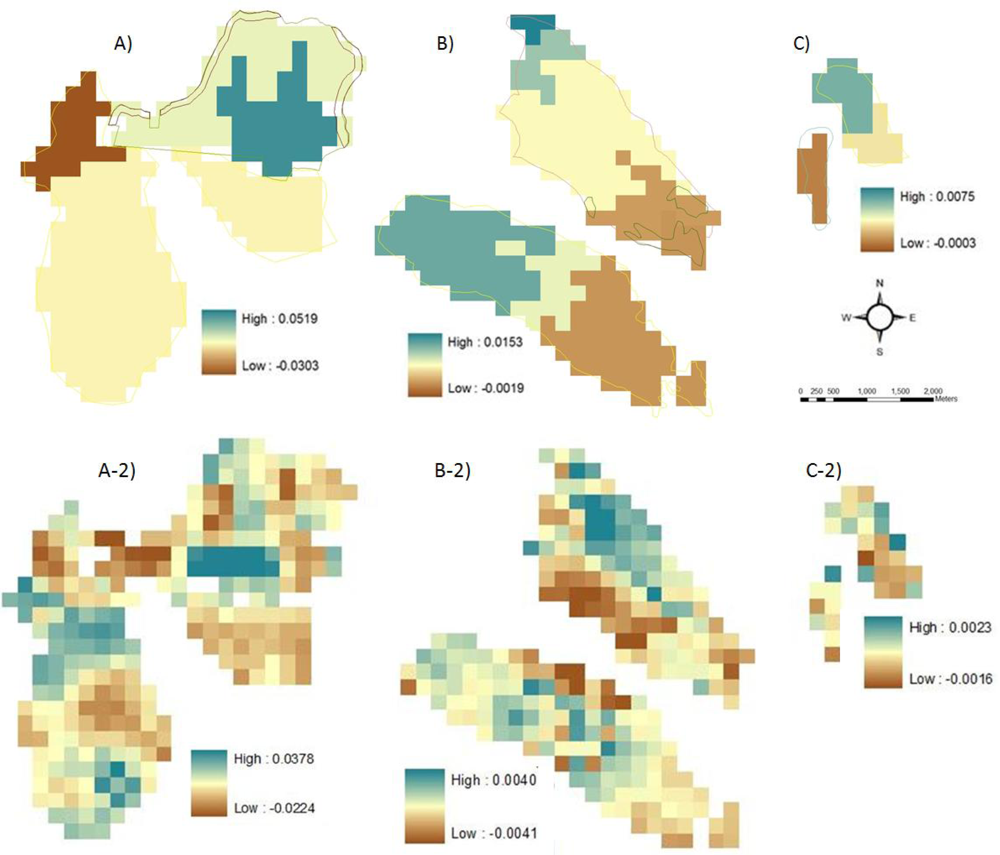
| Fire Name | Time of Fire | Scene Before Fire | Scene After Fire |
|---|---|---|---|
| Capulin | 5/21/06–6/24/06 | 9/24/2004 | 8/16/2007 |
| Mid Elevation Mesas | 3/4/99–3/10/99 | 8/23/1998 | 9/13/2000 |
| Upper Frijoles | 11/5/07–12/31/07 | 8/16/2007 | 8/2/2008 |
| Fire | Treatment | Mean NDVI | ||||
|---|---|---|---|---|---|---|
| AF | IPY | SD (IPY) | % (IPY) | Ratio | ||
| Capulin | Burned Untreated | 0.3983 | 0.0008 | 0.0008 | 0.2101 | 0.1723 |
| Reference | 0.4008 | 0.0049 | 0.0022 | 1.2119 | 1.0000 | |
| Frijoles Canyon | Burned Treated | 0.6891 | 0.0122 | 0.0103 | 1.7707 | 1.8268 |
| Burned Untreated | 0.6813 | 0.0192 | 0.0140 | 2.8131 | 2.8692 | |
| Reference | 0.7160 | 0.0067 | 0.0109 | 0.9329 | 1.0000 | |
| Mid Elevation Mesas | Burned Treated | 0.3851 | 0.0054 | 0.0032 | 1.4071 | 0.8949 |
| Burned Untreated | 0.3873 | 0.0021 | 0.0015 | 0.5324 | 0.3406 | |
| Reference | 0.3776 | 0.0061 | 0.0039 | 1.6033 | 1.0000 | |
| Fire Name | Treatment Type | Pre Fire NBR | Post Fire NBR | DNBR | Elevation | Aspect | Slope | Adj. R2 | RMSE |
|---|---|---|---|---|---|---|---|---|---|
| Capulin | Burned Untreated | - | + | + | 0.854 | 0.0003 | |||
| Reference | + | + | - | 0.588 | 0.0011 | ||||
| Frijoles Canyon | Burned Treated | - | 0.264 | 0.0088 | |||||
| Burned Untreated | - | - | 0.347 | 0.0113 | |||||
| Reference | - | - | + | 0.24 | 0.0095 | ||||
| Mesa Fire | Burned Treated | + | + | - | + | 0.726 | 0.0017 | ||
| Burned Untreated | + | + | 0.408 | 0.0011 | |||||
| Reference | - | - | + | + | 0.888 | 0.0013 | |||
| Usage (%) | 50 | 50 | 37.5 | 62.5 | 62.5 | 12.5 | |||
Share and Cite
Leon, J.R.R.; Van Leeuwen, W.J.D.; Casady, G.M. Using MODIS-NDVI for the Modeling of Post-Wildfire Vegetation Response as a Function of Environmental Conditions and Pre-Fire Restoration Treatments. Remote Sens. 2012, 4, 598-621. https://doi.org/10.3390/rs4030598
Leon JRR, Van Leeuwen WJD, Casady GM. Using MODIS-NDVI for the Modeling of Post-Wildfire Vegetation Response as a Function of Environmental Conditions and Pre-Fire Restoration Treatments. Remote Sensing. 2012; 4(3):598-621. https://doi.org/10.3390/rs4030598
Chicago/Turabian StyleLeon, Jose Raul Romo, Willem J.D. Van Leeuwen, and Grant M. Casady. 2012. "Using MODIS-NDVI for the Modeling of Post-Wildfire Vegetation Response as a Function of Environmental Conditions and Pre-Fire Restoration Treatments" Remote Sensing 4, no. 3: 598-621. https://doi.org/10.3390/rs4030598
APA StyleLeon, J. R. R., Van Leeuwen, W. J. D., & Casady, G. M. (2012). Using MODIS-NDVI for the Modeling of Post-Wildfire Vegetation Response as a Function of Environmental Conditions and Pre-Fire Restoration Treatments. Remote Sensing, 4(3), 598-621. https://doi.org/10.3390/rs4030598







